Tamagotchi gets first UK store as global sales double

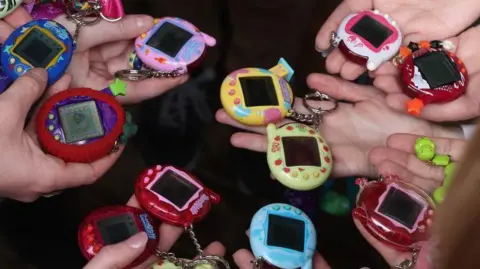 Getty Images
Getty ImagesTamagotchi is having a moment – again.
The egg-shaped toy housing a virtual pet was one of the biggest crazes of the 1990s.
And several attempts to reignite the brand over the years appears to have now paid off for owner Bandai Namco.
Global sales more than doubled between 2022 and 2023, it tells the BBC, and Tamagotchi has now opened its first shop in the UK – something it didn’t even do when it was 1996’s hottest gadget.
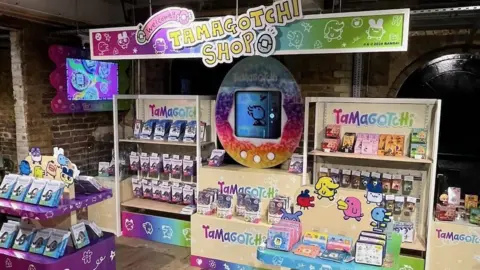
Unsurprisingly, the modern Tamagotchi isn’t the same thing you would have bought in the 1990s.
It still looks the same – a garishly coloured egg with a small digital screen and buttons – but the actual toy has much more functionality.
“Now you can connect with friends, you can play on Wi-Fi and download different items, and that’s really combating that sense of fatigue that you might have gotten with some earlier models,” Tamagotchi brand manager Priya Jadeja told the BBC.
The virtual pet officially relaunched in the UK in 2019 and has been growing since – with a perhaps surprising mix of players young and old.
“When we relaunched, we thought it would be a very millennial-focused relaunch,” Ms Jadeja says.
“But it’s being introduced to kids who’ve never had this sort of device before – it’s really exciting to see them embracing it.”
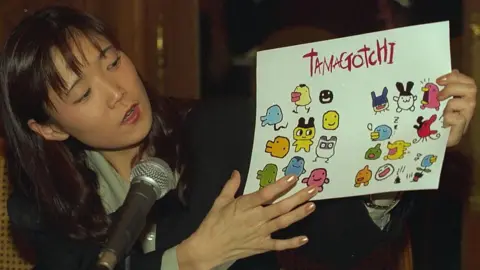 Getty Images
Getty ImagesUnlike in 1996, now there are many other virtual pets on the market.
For example Bitzee, made by Hatchimals, uses a flexible display that responds to your touch, and reacts to tilt-based movement.
Meanwhile Punirunes has a popular feature where you can place your finger inside the toy to “stroke” the virtual pet on the screen.
And there’s also Digimon virtual pets – another 1990s throwback – though these are also owned by Bandai Namco, and were originally designed as Tamagotchi for boys.
Despite those gender-based lines being drawn back in the day, Jadeja says there doesn’t seem to be any real difference in who buys the toys now.
For the Tamagotchi fans we spoke to, nostalgia is playing a big role.
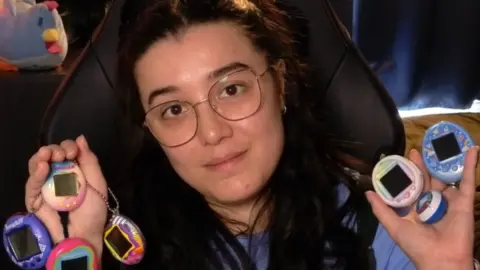 EmmalutionYT
EmmalutionYT“I got my first Tamagotchi back in primary school, my best friend had one back then and I have fond memories of playing with them together,” says Emma, known on YouTube as Emmalution. She says she “started craving some of that nostalgia”.
She didn’t keep her old Tamagotchi and picked up a modern one last year, she says.
“This kickstarted an obsession, absorbing loads of information about all of the releases that had come out after my first ever Tamagotchi,” she said.
“I started a collection, curious to know what I’d been missing out on whilst I was too busy growing up.”
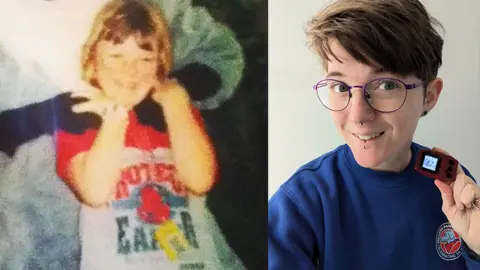 Lost in Translationmon
Lost in TranslationmonKoby, known to his fans on YouTube as Lost in Translationmon, agreed.
“When I’m playing with my Digimon or Tamagotchi virtual pets, I get a small snapshot of what it was like when I first played with my virtual pets as a kid.
“There’s also a fantastic sense of community from sharing photos and stories online with other people.”
And for Emma, there is one other big factor – escapism.
“With how the world is at the moment, and how it has been for the past few years, it’s nice to just look down at your little pixel pet every now and again, forget it all for a moment to feed it a little snack or play a little game, and remember a much simpler time.”
Related
Why investing in women is a vital next step for…
Get Nadine White's Race Report newsletter for a fresh perspective on the week's newsGet our free newsletter from The Independent's Race CorrespondentGet our fre
Business secretary signals major shift on electric car policy to…
In a determined effort to retain Nissan’s manufacturing presence in Britain, Business Secretary Jonathan Reynolds has vowed to implement “substantial c
Joint Statement: Business Secretary and Fujitsu Services Ltd
Business and Trade Secretary Jonathan Reynolds today (Friday 7 March) met chiefs for Fujitsu in Tokyo to begin talks over the cost of redress for victims of th
UK foreign secretary backs multilateral defence funding for Europe
UK foreign secretary David Lammy has said that a new multilateral fund will be needed to secure Europe’s defence as he confirmed that Britain is “open to”














